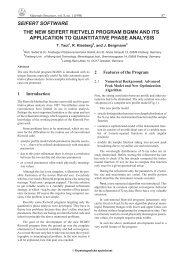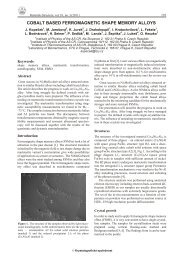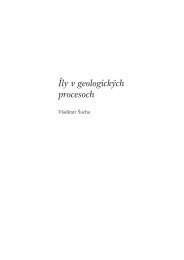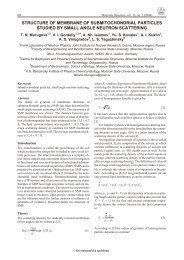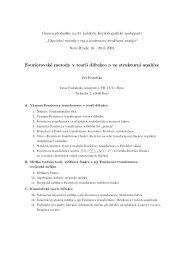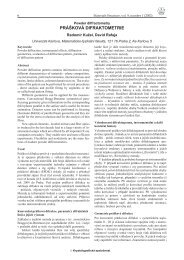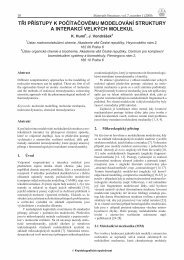x- ray diffraction line profile analysis of strongly textured thin films
x- ray diffraction line profile analysis of strongly textured thin films
x- ray diffraction line profile analysis of strongly textured thin films
You also want an ePaper? Increase the reach of your titles
YUMPU automatically turns print PDFs into web optimized ePapers that Google loves.
X- RAY DIFFRACTION LINE PROFILE ANALYSIS OF STRONGLY TEXTURED THIN FILMS 13<br />
In case <strong>of</strong> continual sputtering there is a [001] preferred<br />
orientation <strong>of</strong> crystallites perpendicular to the substrate.<br />
Cyclic sputtering and ion etching <strong>of</strong> <strong>films</strong> in the<br />
course <strong>of</strong> deposition with 75% <strong>of</strong> O 2 content in the Ar/O 2<br />
gas mixture resulted in [110] preferred orientation <strong>of</strong> ZnO<br />
grains perpendicular to the substrate. After cyclic sputtering<br />
and ion etching <strong>of</strong> <strong>films</strong> with 40% O 2 content in the<br />
Ar/O 2 gas mixture a very strong preferred orientation <strong>of</strong><br />
ZnO crystallites in the [001] direction perpendicular to the<br />
substrate was observed again.<br />
The aluminium conductive layer resulted in a decrease<br />
<strong>of</strong> preferred orientation <strong>of</strong> ZnO crystallites (Figures 1 and<br />
3) as well as decrease <strong>of</strong> lattice imperfections, which can be<br />
observed in decreasing <strong>of</strong> microdeformations. Furthermore,<br />
in all cases <strong>of</strong> ZnO <strong>films</strong> a considerable shift <strong>of</strong> (002)<br />
and (110) <strong>diffraction</strong> <strong>line</strong>s towards the less <strong>diffraction</strong> angles<br />
was observed (See Table 2). Regular positions <strong>of</strong> (002)<br />
and (110) ZnO <strong>line</strong>s according to JCPDS standard are<br />
34.44 and 56.55 deg respectively. This <strong>line</strong> displacement is<br />
accompanied with the lattice strains which are present in<br />
the ZnO <strong>films</strong> due to lattice mismatch between the layer<br />
and substrate and due to the low-energy ion bombardment<br />
<strong>of</strong> <strong>films</strong>.<br />
The texture evolution depending on the substrate temperature<br />
during the deposition can be demonstrated on<br />
Zn x O y /Al x O y multilayered structures prepared as sensitive<br />
layers for UV radiation. When substrate temperature during<br />
the deposition was kept below 300 o C, a part <strong>of</strong> amorphous<br />
phase was also observed. Much better preferred orientation<br />
was observed when substrate temperature was<br />
kept on 600 o C (See Figure 4 and Table 2).<br />
The most expressive preferred orientation <strong>of</strong> crystallites<br />
in the [111] direction perpendicular to the substrate<br />
was observed in case <strong>of</strong> metallic Ag, Pd and Pt <strong>films</strong>. These<br />
<strong>films</strong> are suitable materials for chemical and bio-chemical<br />
sensors as catalytic metal layers or as reference electrodes.<br />
XRD-scans <strong>of</strong> (111) <strong>line</strong>s are demonstrated in Figures 5, 6<br />
and 7.<br />
Figure 3. Influence <strong>of</strong> O 2 content in gas mixture on preferred orientation<br />
<strong>of</strong> ZnO film (Ar/O 2 =60/40 %)<br />
Figure 5. XRD-scan for (111) <strong>line</strong> <strong>of</strong> Ag film deposited on single<br />
crystal<strong>line</strong> Si [100] substrate<br />
Figure 4. Influence <strong>of</strong> substrate temperature on preferred orientation<br />
<strong>of</strong> Zn x O y /Al x O y multilayered structures (Ar/O 2 = 25/75 %)<br />
Figure 6. XRD-scan for (111) <strong>line</strong> <strong>of</strong> Pd film deposited on single<br />
crystal<strong>line</strong> Si [100] substrate<br />
In this case, only (111) <strong>line</strong> and its second order were<br />
observed. Degree <strong>of</strong> preferred orientation can be partially<br />
appreciated by the width <strong>of</strong> the omega-scans <strong>of</strong> (111) <strong>line</strong>s.<br />
The widths <strong>of</strong> the omega-scans for (111) <strong>line</strong>s <strong>of</strong> investigated<br />
Ag and Pt <strong>films</strong> are about 3.3-3.7 deg. For Pd film it<br />
is about 6.4 deg. Higher r.f. power applied in the sputtering<br />
unit resulted in a higher degree <strong>of</strong> preferred orientation <strong>of</strong><br />
crystallites.<br />
4 Conclusions<br />
Our experiments indicated that the X-<strong>ray</strong> <strong>diffraction</strong><br />
<strong>line</strong> <strong>pr<strong>of</strong>ile</strong> <strong>analysis</strong> carried out on a common X-<strong>ray</strong> powder<br />
diffractometer can be successfully used when investigating<br />
the microstructural properties <strong>of</strong> <strong>strongly</strong> <strong>textured</strong> <strong>thin</strong><br />
© Krystalografická spoleènost



